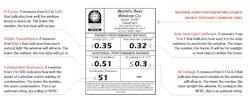Windows have come a long way in the past few decades. Advancements in glass, framing, hardware, and performance have created more options—and complexity—for remodelers and homeowners alike.
Continued growth of this category presents a big business opportunity: The residential window and door market will exceed 60 million units in the next few years, with more than half being used in replacement, according to the Window and Door Manufacturers Association.
To stay ahead in a competitive market, remodelers should lean on manufacturers to provide education and resources.
Performance Is Key
In my experience, one of the best sales tools is also the simplest: explaining to homeowners why windows and doors matter. And a big part of that is performance. While it’s important to highlight design and functionality, helping homeowners understand trade-offs between cost and comfort, energy savings, noise control, and impact-resistance allows remodelers to position themselves as real solution providers. Although code compliance is a good starting point, many homeowners are interested in upgrading to products that offer higher performance beyond code with superior sustainability.
Over the past decade, there have been significant advances in low-emissivity (low-E) coatings, which allow us to “tune” windows to specific regional conditions—higher solar control in the south and enhanced thermal performance (U-value) in northern climates. Window labels can help inform the window selection process and identify the most suitable window.
As an example, the label below from the National Fenestration Rating Council (NFRC) is required on all windows certified by the group. It provides the thermal performance (U-value and Solar Heat Gain Coefficient) for the specific window configuration. Lower U- and SHGC values mean better overall thermal performance and four-season comfort.
Another commonly used label, seen below on the far left, is applied to Energy Star-rated windows and includes a U.S. map to help homeowners determine if the window meets their regional requirements.
Finally, the American Architectural Manufacturers Association has updated its labeling (see below and to the right) to show how windows perform and to enable easier product comparison. As with NFRC, the label is affixed to certified windows.
Often what drives the decision to specify a certain window is familiarity and cost. But by taking a more holistic approach, remodelers can better educate homeowners and really demonstrate what’s possible in terms of product performance.

